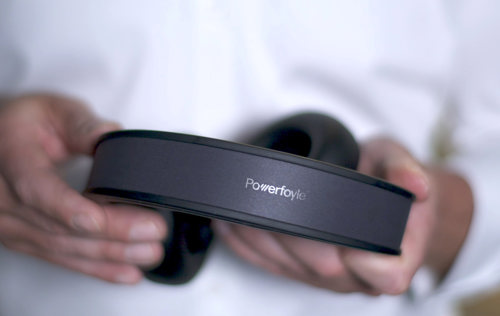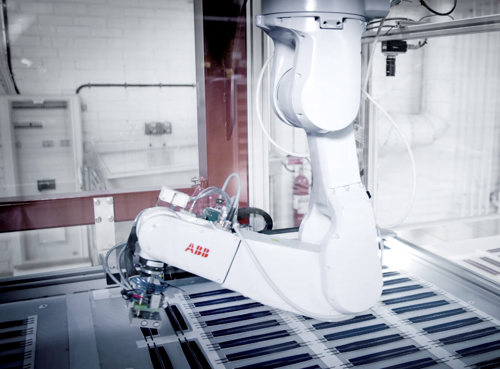The privately owned Swedish company Exeger has developed what it describes as a unique solar cell technology that can convert all forms of light into electrical energy.
Designed to be both resilient and flexible the team at Exeger have created a material named Powerfoyle that can be seamlessly integrated into a broad range of products that will benefit from being self-powered.
According to Exeger, its Powerfoyle die-sensitised solar technology can deliver extended or even eternal battery life and puts the power of cutting-edge solar technology directly into the hands of consumers.
“It’s a new power source and we’re working to revolutionise the perception of available energy. We’re looking to make products that are both smarter and more sustainable,” explained Nicklas Jonsson, the company’s Chief Product Officer, to New Electronics.
The company’s technological platform has been optimised for indoor light and first came to market back in 2021. Since then, it has been working to take this impressive R&D achievement and to embed it into a growing number of consumer products.
At an analysts’ meeting earlier this year the company’s CEO, Giovanni Fili said, “It’s an incredible achievement that we have been able to boost indoor efficiency with a 50% power increase. But it’s now, when we have started to power products with this technology, that we’ll start to make a real difference. It’s particularly valuable as many consumer electronics and IoT products are primarily used indoors.”

The market for smart and connected devices is certainly huge with some research analysts expecting it to be worth over $1 trillion by 2030.
According to Exeger, it is looking to accelerate this growth by removing one of the IoT’s biggest hurdles – power - and is working with a lengthening list of companies to develop self-powered products using its Powerfoyle technology to harvest energy from all forms of available light.
“It will help to speed up the transition to truly smart and connected products in both a user and environmentally friendly way,” said Jonsson.
To date Exeger has developed its Powerfoyle technology so that it can be integrated into devices such as trackers, sensors, remote controls, electronic shelf labels, keyboards, mouses and more.
“Our innovative solar cell technology can transform any form of light into electrical power, no matter where the device is, and we’ve come up with a material than can be integrated into a broad range of products that benefit from being self-powered,” explained Jonsson.
At CES earlier this year the company unveiled a collaboration with the Dutch audio-tech start-up, Mayht and has created the world’s first light-powered speakers with infinite playtime. A prototype was displayed behind closed doors but was used to demonstrate charging using both natural (sunlight) and ambient (indoor) light.
“This combination of Powerfoyle with Mayht’s HeartMotion speaker driver technology will mean that consumer electronics manufacturers will no longer be constrained by the limits of conventional speakers and will be able to offer truly unlimited battery life,” said Jonsson.
At the end of June Exeger announced that Jays, an audio product brand owned by the Swedish Northbaze Group, would be purchasing its Powerfoyle solar cells for its audio products.
Jays places a strong emphasis on good design and what it calls an ‘effortless user interface’ and, according to Jonsson, saw the value of Powerfoyle in that it would be able to remove the hassle associated with charging consumer devices.
A decade of scientific research
“Powerfoyle has been brought to market after more than a decade of scientific research and industry development,” explained Jonsson. “We believe that we have developed a world-changing material that drives new possibilities for people and how they will be able to use everyday products.”
Powerfoyle has been designed to be both flexible and resilient and to provide engineers with a material that can be seamlessly designed into all types of applications.
“The material converts any light into electrical energy and does so using a process that’s been inspired by the natural principle of photosynthesis. With this material technology, we wanted to be able to improve all current and future products and solutions and provide users with an endless supply of energy,” explained Jonsson.
Traditional flexible solar cells have to use silver lines to transport the current generated and due to high levels of resistance cells have to collect the current before passing it along cables.
“Our innovation does away with all of that,” explained Jonsson.

The company, which is based in the heart of Stockholm, has developed what Jonsson describes as, “an urban factory” where research and engineering have been brought together enabling these new solar cells to be manufactured on an industrial scale.
“We employ upwards of 200 people and are in the process of building our second factory here in Stockholm,” added Jonsson.
The fundamental research into the underlying chemistry that has given rise to Powerfoyle began over 12 years ago, according to Jonsson.
“Today, Powerfoyle is now appearing in products and is distinguishable from its competitors as it works best in low and moderate light. The material is flexible and comes with connection points at the back.
“It can be deployed in headphones, helmets, and portable speakers, for example.
“We wanted to develop a material that both looks good and is much thinner and we’ve achieved that. We have stripped away the traditional conductive layer found in solar cells and replaced it with an electrode nanomaterial that is not only slimmer but is 1000 times more conductive than the traditional materials used in solar cells. It’s placed inside the stack to create a complete cell.”
“The unique substrate that we have created comprises of five different layers, one of which is the conductive layer, and the stack is hermetically sealed. The production process is patented and over three years ago we developed a specific customisable layer than can, in the laminating process, be made to look like the customer’s preferred option.
“Critically, especially in consumer goods, the solar cell is flexible and durable. In consumer tests it has been proved to be both scratch and chemical resistant,” according to Jonsson.
One impressive example of how Powerfoyle has been used is with the development of solar-powered headphones from Urbanista Los Angeles.
“The solar cell material is located on the outside top of the headband and has been designed to blend in with the overall design of the headphones,” explained Jonsson.
In order to keep the headphone charged all the user needs to do is place them under a light – a window, a lamp or even a lightbulb – but they will continue to charge even when being worn.
“It’s clean, non-stop energy, and in daily testing it never ran out of power,” according to Jonsson, and, critically, “there is no need for cables.”
Beyond the consumer space Exeger is now looking at the enterprise space.
“We’ve developed a special polycarbonate helmet with an inbuilt solar cell. It’ll be possible to add a range of sensors to the helmet and to develop a number of applications for this technology from monitoring temperature and humidity to checking the health and safety of workers. Once you get into the enterprise space it is a very interesting and diverse market.”
“Our focus is now on developing strategic partnerships and collaborations with leading companies, as we look to find new ways in which our material can disrupt markets,” said Jonsson.
”Our aim as a company is to drive a new era of self-powered products for a smarter and more sustainable world.”













